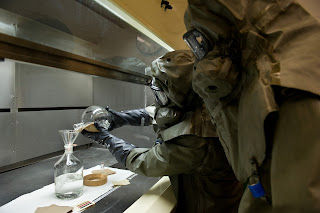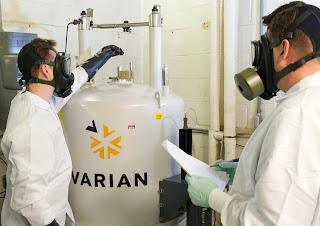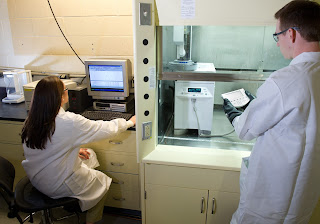On a Thursday morning in June, former Engineering Directorate Executive Officer (XO) Todd Nay, and current Engineering Directorate XO Amy Maxwell discussed the rotational position over breakfast. The Engineering Edge was present to capture their perspectives on ECBC’s prestigious rotational program.
About the XO:
Todd Nay
Duration of XO Tenure:November 2012-May 2013
Previous position:ECBC Safety Office, Safety Engineer
Little known fact:Todd and his wife were featured on HGTV’s “Bang for Your Buck” television show. While he and his wife won the television competition by creating the best renovations at a cheap price, the show did not award prizes for winning at that time, so they still went home empty handed.
Amy Maxwell (AM): How do you think the XO position benefitted your career?
Todd Nay (TN): Since I came from Safety, I was already used to interacting with a lot of people so I think the XO position helped me in two ways. First off, it helped me develop better relationships with people within the Engineering Directorate. While I’ve worked with engineers before, I feel like I have a better relationship with the Engineering supervisors. Being back in the Safety office, I feel like now I know who to reach out to if I have a problem. In my current position, I’ve been able to reach out to supervisors who I’ve met through the XO program for help. Building that awareness and those relationships definitely made my job easier.
The second benefit is that it has enhanced my presentation skills. As a safety engineer, I brief and send emails to senior leadership about safety issues. Having the opportunity to work closely with senior leadership for six months and attend their meetings, I have gotten a better sense of the type of information they want and types of questions I should anticipate. This allows me to tailor the presentation material to make sure it covers exactly what they need.
AM: Would you say the XO position has expanded your network and visibility with ECBC and non-ECBC personnel?
TN: It did expand my network, though primarily with supervisors. I also met several non-supervisors and had the opportunity to meet other people who directly support the leadership. I expanded my network outside of ECBC as well. I attended multiple Joint Project Executive Office (JPEO) and Joint Program Manager (JPM) meetings, so I had the opportunity to meet people at that level. The XO position helped me get my foot in the door with both the PMs and the Engineering Directorate employees matrixed to them. As a result of my interactions with the JPEO and JPMs, I’m hoping to work closely with them to help them establish some safety programs.
AM: How did the XO Program expand your knowledge of the Center and its capabilities?
TN: Coming from the Safety Office, I had a good command of what the Center does. The biggest benefit from the XO position for me, was gaining an understanding of ECBC’s external relationships and competition, as well as understanding the kinds of things that management deals with every day.
AM: If you could go back, is there anything that you would have changed about your time as XO?
TN: One project I tried to accomplish was to schedule one-on-ones with the Division Chiefs. Unfortunately, I didn’t get to meet with all of them but made it to some. If I could go back, I would start the process of scheduling the one-on-ones with them sooner than I had, so that I could get to everybody. I also wish I had gotten the chance to schedule the same one-on-ones with branch chiefs. I met and talked to a few of them, but I wish I had gotten a little more personal interaction with them as well.
AM: What advice would you give to me as a new XO?
TN: Be deliberate with the Directorate leadership about goals that you want to achieve. In the Engineering Directorate, the leadership is intentional about helping you achieve the goals you set for yourself as an XO. They are very conscious about placing you in the right position to achieve whatever goals you may have. For me, I wanted to expand my network, so they helped me be able to attend the right meetings with them and interact with the best people. I really appreciate the opportunity they gave me to make the position something that I could greatly benefit from.
ABOUT THE XO
AMY MAXWELL
Duration of XO Tenure: May 2013-present
Previous position: Project Management CBR Filtration Branch, Research and Technology Directorate
Little known fact: Amy was a ballet dancer for 20 years, but then stopped when she had kids. Amy had been dancing since she was five years old doing ballet, dance, tap and many other forms of dance. While Amy has not danced in a while she would like to get back into it.
Todd Nay (TN): What position did you hold previous to the XO rotation? Amy Maxwell (AM): I was a member of the CBR Filtration Branch within the Research and Technology (R&T) Directorate. I was mainly in a project manager role over there. I ran a project that came in from research with the Defense Threat Reduction Agency. I also do a lot of test and evaluation (T&E) work. Since I have a T&E background that is something I continue to do in my role.
When I was initially brought onto the team, I worked on a test methodology standardization project that lasted five to six years. I occasionally worked in the lab, but that was not my primary function. I needed to get Dugway, Eglin, Air Force Research Lab, Natick and ECBC to work together to develop standard test methods. The six years this project took, accounted for most of my time with the Branch. I’ve done smaller projects in-between as well.
Prior to working on the CBR Filtration Branch, I was an employee in the Engineering Directorate for three years. The transition between the two directorates was a bit of a learning curve but was not a total shock to me. While the management styles between the two directorates are pretty different, the expectation to deliver quality work is the same. Coming back to Engineering in the XO role is pretty different as well. I think the Directorate has changed a lot since the eight years I have been working in R&T. When I was in Engineering, there was no formalized strategic management process, there was different management, the projects were different and the budget situation was not what it was today. The changes keep things interesting though.
TN: What are your personal goals as an XO?
AM: I would like to build my network back up again in the Joint Project Manager areas. I had that when I worked in Engineering, but it’s been so long I have not been able to maintain those relationships. I also wanted to gain insights into the functions of the Center: the budgeting, the people perspective and the Goal Teams. Through learning more about that, I can see where I might be able to support at a Center level. I would like to find ways to make an impact at the Center level. I think it might be rewarding for me and hopefully the Center. I also want to see if I can get more Center exposure to T&E. I found that many people don’t understand the critical methodology programs that we create at the Center-level. I’m hoping to have the opportunity to educate people on that.
TN: Did you know any of the other XOs prior to your rotation?
AM: I knew Kari Wiesner from when she worked at the Protective Factor chamber. I didn’t know Rich Wallace or Mike Mays at all. So, it was nice to meet new people, and see new faces.
TN: Prior to ECBC where have worked?
AM: I worked at Corning Incorporated for about two years, and I really liked the company, but the plant shut down. When I started there as a process engineer in 1999, the company was involved in the telecommunications industry working with optical fiber and producing amplifiers. In early 2001, investors in the telecommunications industry backed away, and the entire industry plummeted. Over several rounds, everybody in the plant was laid off. While the company asked several of us to return to other jobs, I decided to look for a job elsewhere. I liked the company, but with no ties to the area, I was ready for a change and ECBC has been a great fit.






















